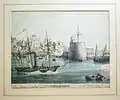Vue d'optique (French), vue perspective or perspective view refers to a genre of etching popular during the second half of the 18th century and into the 19th. Vues d'optique were specifically developed to provide the illusion of depth when viewed through a zograscope, also known as an "optical diagonal machine" or viewers with similar functions.
Characteristics
- Reversed type in some or all of the text, for viewing through a mirrored apparatus
- Bright hand-coloring
- Scenes chosen for their strong linear perspective (for example, diagonal lines converging at a horizon)
- Subject matter appealing to armchair travelers: shipping, cities, palaces, gardens, architecture.[1]
History
Optical viewers were generally popular with well-to-do European families in the late 18th and early 19th centuries. Perspective views were produced in London, Paris, Augsburg and several other cities.[2][3]
Gallery
 Vue d'optique of Havre de Grace Port of Paris printed in Germany ca. 1800.
Vue d'optique of Havre de Grace Port of Paris printed in Germany ca. 1800. Vue d'optique of the Bridge of La Concorde, Printed in Paris
Vue d'optique of the Bridge of La Concorde, Printed in Paris Vue d'optique of the Hotel Royal des Invallides, printed in Paris
Vue d'optique of the Hotel Royal des Invallides, printed in Paris Vue d'optique of Rome, printed in Paris
Vue d'optique of Rome, printed in Paris Vue d'optique of the Hotel de Ville in Amsterdam, printed in England
Vue d'optique of the Hotel de Ville in Amsterdam, printed in England
References
- ↑ Kaldenbach, Kees. "Perspective Views". Retrieved 27 Feb 2013. Originally published in Print Quarterly (June 1985)
- ↑ Philographikon. ""Vue d'Optique" or "Perspective View"". Retrieved 27 Feb 2013.
- ↑ Kaldenbach, Kees. "Perspective Views". Retrieved 27 Feb 2013. Originally published in Print Quarterly (June 1985)
This article is issued from Wikipedia. The text is licensed under Creative Commons - Attribution - Sharealike. Additional terms may apply for the media files.